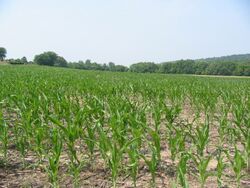Biology:Azotobacter chroococcum
| Azotobacter chroococcum | |
|---|---|

| |
| Image of a corn field on which A. chroococcum could be used as a biofertilizer | |
| Scientific classification | |
| Domain: | Bacteria |
| Phylum: | Pseudomonadota |
| Class: | Gammaproteobacteria |
| Order: | Pseudomonadales |
| Family: | Pseudomonadaceae |
| Genus: | Azotobacter |
| Species: | A. chroococcum
|
| Binomial name | |
| Azotobacter chroococcum Beijerinck 1901[1]
| |
Azotobacter chroococcum is a bacterium that has the ability to fix atmospheric nitrogen. It was discovered by Martinus Beijerinck in 1901, and was the first aerobic, free-living nitrogen fixer discovered.[2] A. chroococcum could be useful for nitrogen fixation in crops as a biofertilizer, fungicide, and nutrient indicator, and in bioremediation.
Characteristics
A. chroococcum is a microaerophilic plant growth-promoting rhizobacterium (PGRP),[3][4] which is bacillus in shape and is Gram negative.[4] As a mesophile, this bacterium grows best in moderate-temperature soils and requires a neutral pH environment.[citation needed] It is able to fix nitrogen under aerobic conditions.[3] The soil cannot be poor in phosphorus or else nitrogen fixing can be hindered. In addition to phosphorus, these bacteria needed potassium, "sulphur, magnesium, and calcium" to grow.[citation needed] To fix nitrogen A. chroococcum produces three enzymes (catalase, peroxidase, and superoxide dismutase) to "neutralise" reactive oxygen species. It also forms the dark-brown, water-soluble pigment melanin at high levels of metabolism during the fixation of nitrogen, which is thought to protect the nitrogenase system from oxygen.[3] In the presence of some saccharides (such as sucrose and raffinose) while on agar plates, a levan ring can form around the A. chroococcum colony.[5]
Uses
Research has been carried out into A. chroococcum's potential applications in improving crop production. At least one study has so far shown a significant increase in crop production linked to the production of "auxins, cytokinins, and GA–like substances" by A. chroococcum.[6] In addition to these biomolecules, this bacterium has been found to be able to produce "siderophores, ammonia, and ACC deaminase", as well as indoleacetic acid, which all are known to assist with the growth of crops.[4]
On top of helping with the growth of crops in general, A. chroococcum has also been shown to help crops grow in polluted soils. A. chroococcum is able to survive and improve the growth of crops in soils polluted with heavy metals when seeds are inoculated with the bacterium prior to planting.[4] A. chroococcum not only produced growth-positive biomolecules and increased the number and quality of maize kernels, but also reduced the production of "proline, antioxidant enzymes, and MDA" in the plants, all which indicate of the presence of heavy metals in the soil.[4]
In addition to treating soils polluted with heavy metals, A. chroococcum can act as a fungicide that can be used to treat soils and plants inflicted with fungal infections, specifically fungi that are susceptible to "fungicidal substances of the anisomycin group".[citation needed]
This bacterium can also be used to determine the nutrient composition of the soil. Since plants and A.chroccoccum both need phosphorus and potassium to grow, this bacterium can be used to determine if the soil is fit for crop growth, as it would thrive in soils that have these nutrients.[citation needed]
A. chroococcum is also a possible asset for bioremediation. Melanin produced by this bacterium can bind to heavy metals, subsequently protecting A. chroococcum, which may be useful for removing heavy metals from polluted soils.[4] Since this bacterium is able promote plant growth through nitrogen fixation, it can also reduce the amount of nitrogen that has to be added to fields, which can reduce the amount of nitrogen runoff. This effect of less nitrogen being added in soil was seen in a study involving cotton plants.[7]
References
- ↑ Parte, A.C.. "Azotobacter". LPSN. https://lpsn.dsmz.de/genus/azotobacter.
- ↑ Beijerinck M. W. (1901). "Ueber Oligonitrophile Mikroben" (in German). Zentralblatt für Bakteriologie, Parasitenkunde, Infektionskrankheiten und Hygiene, Abteilung II (7): 561–582.
- ↑ 3.0 3.1 3.2 Shivprasad S., Page W. J. (1989). "Catechol Formation and Melanization by Na+ -Dependent Azotobacter chroococcum: a Protective Mechanism for Aeroadaptation?". Applied and Environmental Microbiology 55 (7): 1811–1817. doi:10.1128/AEM.55.7.1811-1817.1989. PMID 16347974. Bibcode: 1989ApEnM..55.1811S.
- ↑ 4.0 4.1 4.2 4.3 4.4 4.5 Rizvi, Asfa; Kahn, Mohd. Saghir (August 15, 2018). "Heavy metal induced oxidative damage and root morphology alterations of maize (Zea mays L.) plants and stress mitigation by metal tolerant nitrogen fixing Azotobacter chroococcum". Ecotoxicology and Environmental Safety 157: 9–20. doi:10.1016/j.ecoenv.2018.03.063. PMID 29605647.
- ↑ Robson, Robert L.; Jones, Robert; Robson, R. Moyra; Schwartz, Ariel; Richardson, Toby H. (June 10, 2015). "Azotobacter Genomes: The Genome of Azotobacter chroococcum NCIMB 8003 (ATCC 4412)". PLOS ONE 10 (6): 5–6. doi:10.1371/journal.pone.0127997. PMID 26061173. Bibcode: 2015PLoSO..1027997R.
- ↑ Wani, Sartaj; Chand, Subhash; Ali, Tahir (29 August 2013). "Potential Use of Azotobacter chroococcum in Crop Production: An Overview". Current Agriculture Research Journal 1 (1): 35–38. doi:10.12944/CARJ.1.1.04.
- ↑ Wang, Juanjuan; Li, Ruochen; Zhang, Hui; Wei, Gehong; Li, Zhefei (2020-02-21). "Beneficial bacteria activate nutrients and promote wheat growth under conditions of reduced fertilizer application". BMC Microbiology 20 (1): 38. doi:10.1186/s12866-020-1708-z. ISSN 1471-2180. PMID 32085752.
External links
Wikidata ☰ Q3565794 entry
 |

